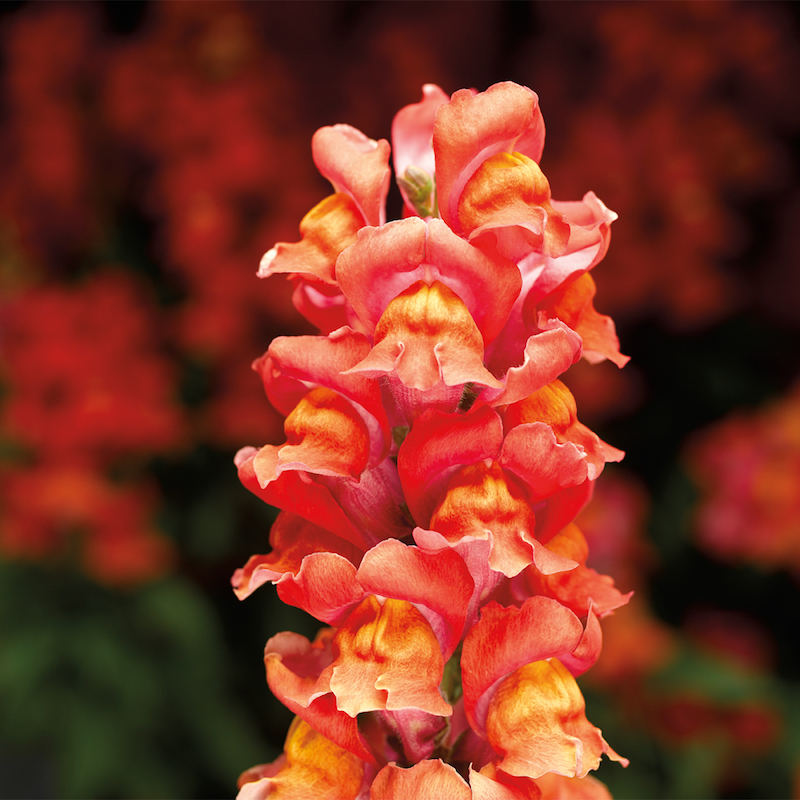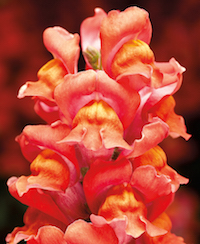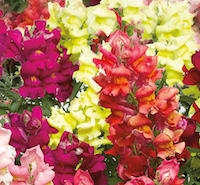These new snapdragons aren’t just fantastic, they’re simply “Snaptastic.” Snaptastic, a new series coming from Syngenta, is considered medium in height, reaching 14 to 16 inches. They fill a void that’s been longed for in the market.
Snapdragons are planted in the fall in much of the country, so as you shop, you’ll likely see these riotous colors tempting you. Snaptastic finds itself right in the middle of the Montego series, which is one of the best dwarfs and reaches 8 to 10 inches tall, and the Liberty Classic series, which hits a height of 24 inches.
Each year I was thrilled to go to the California Pack Trials, as it was called then, to see an acre of snapdragons growing in the field next to the Syngenta Flowers headquarters. It was a sight that would always deliver that Kodak moment. Even then it was apparent that breeding would allow the flowers a full range of heights.
The snapdragon is native to Europe and the Mediterranean, and is known botanically as Antirrhinum majus. No matter where you live, and whether you garden in the landscape or in containers, there is a snapdragon season for you. In addition to staggering beauty in a range of colors, you will also find that snapdragons are resistant to roving deer populations.
So whether you will be doing a spring or fall planting, know that snapdragons are like pansies and prefer a fertile, organic, rich soil in full sun for best bloom production. Incorporate 3 to 4 inches of organic matter, tilling to a depth of 8 to 10 inches, or use a prepared landscape mix like many in the commercial landscape do.
While doing your soil preparation, apply 2 pounds of a slow-release 12-6-6 or balanced fertilizer per 100 square feet of planting area. There are some great new fertilizers that also incorporate a fungicide that helps reduce some of the most prevalent diseases.
Set transplants into the garden at the recommended spacing for your variety. For the Snaptastic series, this would be 8 to 12 inches. Apply a good layer of mulch to keep soil temperatures moderate for the long growing season ahead. A little fertilizer every two to three weeks will keep them growing.
Snapdragons are more cold hardy than many realize. Once established in the landscape and hardened off, they are quite capable of taking subfreezing temperatures. Even if record cold moves in, they can be completely covered with pine straw for a few days with no problem.
Snaptastic is available in five rich colors: yellow, orange, red, magenta — which looks fit for royalty — and a luscious pink. These are also combined in a showy mix. You’ll love Snaptastic as a pansy partner, grown with violas and flowering kale and cabbage. They are most dazzling when planted in mass in front of a backdrop of evergreen shrubs. Don’t forget the opportunities to use Snaptastic varieties with spring bulbs.
Snapdragons don’t require much care — just a little deadheading of spent blooms, watering during dry spells, water-soluble fertilizer and mulching for winter protection. The incredible display of color is sure to bring you joy and make your neighbors green with envy. For more recommendations, follow me on Twitter @CGBGgardenguru. Learn more about the UGA Coastal Botanical Garden at coastalgeorgiabg.org.









